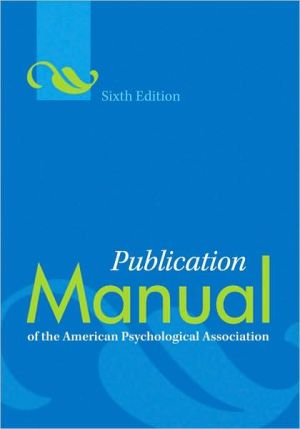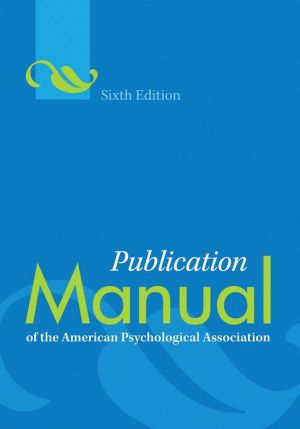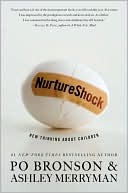Publication Manual of the American Psychological Association, Sixth Edition
The Publication Manual of the American Psychological Association is the style manual of choice for writers, editors, students, and educators in the social and behavioral sciences. It provides invaluable guidance on all aspects of the writing process, from the ethics of authorship to the word choice that best reduces bias in language. Well-known for its authoritative and easy-to-use reference and citation system, the Publication Manual also offers guidance on choosing the headings, tables,...
Search in google:
The Publication Manual of the American Psychological Association is the style manual of choice for writers, editors, students, and educators in the social and behavioral sciences. It provides invaluable guidance on all aspects of the writing process, from the ethics of authorship to the word choice that best reduces bias in language. Well-known for its authoritative and easy-to-use reference and citation system, the Publication Manual also offers guidance on choosing the headings, tables, figures, and tone that will result in strong, simple, and elegant scientific communication. The sixth edition offers new and expanded instruction on publication ethics, statistics, journal article reporting standards, electronic reference formats, and the construction of tables and figures. The sixth edition has been revised and updated to includenew ethics guidance on such topics as determining authorship and terms of collaboration, duplicate publication, plagiarism and self-plagiarism, disguising of participants, validity of instrumentation, and making data available to others for verification;new journal article reporting standards to help readers report empirical research with clarity and precision;simplified APA heading style to make it more conducive to electronic publication;updated guidelines for reducing bias in language to reflect current practices and preferences, including a new section on presenting historical language that is inappropriate by present standards;new guidelines for reporting inferential statistics and a significantly revised table of statistical abbreviationsnew instruction on using supplemental filescontaining lengthy data sets and other media;significantly expanded content on the electronic presentation of data to help readers understand the purpose of each kind of display and choose the best match for communicating the results of the investigation, with new examples for a variety of data displays, including electrophysiological and biological data;consolidated information on all aspects of reference citations, with an expanded discussion of electronic sources emphasizing the role of the digital object identifier (DOI) as a reliable way to locate information; andexpanded discussion of the publication process, including the function and process of peer review; a discussion of ethical, legal, and policy requirements in publication; and guidelines on working with the publisher while the article is in press.Key to this edition of the Publication Manual is an updated and expanded Web presence. Visit the APA Style web site toLook up additional supplemental material keyed to the bookTest your knowledge of APA Style with a free tutorial on style basicsLearn about the changes in the sixth edition with a free tutorial reviewing key revisionsSign up for an on-line course to enrich and enhance your understanding of APA StyleRead the APA Style blog and share your comments on writing and referencingConsult frequently asked questions to sharpen your understanding of APA StyleExamine additional resources on such topics as ethics, statistics, and writingFamiliarize yourself with submission standards for APA books and journalsWhat's New in the Sixth Edition?Book has been updated to acknowledge and incorporate advances in computer technology.New discussions of the creation, submission, and storage of supplemental data.New guidelines for referencing electronic sources.New and expanded reference examples for a variety of on-line sources.Redesigned APAstyle website, expanded to provide tutorials, on-line courses, and other resources for learning APA style.Book has been reorganized and streamlined for ease of useOrganized to describe the writing process from idea to publication, it begins with background information on ethical issues in publishing, then moves on to manuscript structure and content, then writing style and rules, then graphics and references, then guidance on working with the publisher.Sample paper section has been moved up and featured to better exemplify manuscript structure and contentLike discussions have been moved to one place in the book, with discussions of function followed by instruction on form.Focus has been broadened to include readers in the behavioral and social sciences.Information specific to APA has been moved to the web, where it is more broadly accessible and can be updated frequently.New examples throughout the book have been drawn from publications in education, business, and nursing as well as psychology.
Preface\ In 1928 editors and business managers of anthropological and psychological journals met to discuss the form of journal manuscripts and to write instructions for their preparation. The report of this meeting, which was chaired by Madison Bentley and sponsored by the National Research Council, is the forerunner of this book. The report was published as a ven-page article in the February 1929 issue of the Psychological Bulletin, ournal of the American Psychological Association (APA). The group agreed that it would not dictate to authors; instead, it recommended a andard of procedures, to which exceptions would doubtless be necary, but to which reference might be made in cases of doubt" ("Inuctions," 1929, p. 57; see section 9.01 for references to the predecessors this edition of the Publication Manual).\ In the 70 years that followed, those "Instructions" were revised and anded a number of times. The first edition of the instructions under title of Publication Manual was actually a 60-page supplement to the Psychological Bulletin published in 1952.\ It was another 22 years before a new edition was published in 1974 with 136 pages. Publication of the 208-page third edition occurred in 1983, and the fourth edition of 368 pages rolled off the presses in 1994.\ Seven years have elapsed since the last edition, during which time great changes have occurred in the publishing world and in the technology b I authors, editors, and publishers. The fourth edition stood the of time well, but eventually there were more matters to be dealt with than could be easily accommodated on the APA Web site for updates. In 1999 the APA Publications and Communications Board authorized work to begin on this fifth edition of the Publication Manual.\ Leslie Dodson ably served as the project leader for the revision, and many APA members and staff contributed their time, energy, and expertise to the preparation and editing of this volume, Nlark Appelbaum and his colleagues on the Statistics Task Force (Leona S. Aiken, Joel R. Levin, Robert S. Rosen, and Howard Wainer) had a particularly difficult assignment. Although not always in agreement on the specifics, the task force did agree on the need to provide some additional assistance to authors in dealing with statistical representations in manuscripts. Lenore W. Harmon, the APA Chief Editorial Advisor, drew on her experience to work on the ethics and authorship sections and to chair the Task Force on the Publication of Case Material (with Janice Birk, Clara Hill, Ross Parke, and NVilliam Stiles). Kathleen Sheedy took aim at the moving target of electronic referencing and manuscript preparation. She will continue working with the APA Internet Services staff to keep the new APA Style NVeb site up to date with changes in this area as they occur, Susan Knapp and Demarie Jackson provided examples, text, and guidance along the way.\ There is a section in the foreword to the fourth edition that aptly characterizes the Publication Manual.\ The Publicationn Manual presents explicit style requirements but acknowledges that alternatives are sometimes necessary; authors should balance the rules of the Publication Manual with good judgment. Because the written language of psychology changes more slowly than psychology itself, the Publication Manual does not offer solutions for all stylistic problems. In that sense, it is a transitional document: Its style requirements are based on the existing scientific literature rather than imposed on the literature.\ Every edition of the Publication Manual has been intended to aid authors in the preparation of manuscripts. The 1929 guide could gently advise authors on style, because there were then only about 200 authors who published in the 4 existing APA Journals. Today, the editors of APA's 24 primary journals consider close to 6,000 manuscript submissions per year (of which approximately 1,400 reach print). Without APA style conventions, the time and effort required to review and edit manuscripts would prohibit timely and cost-effectivc publication and would make clear communication harder to achieve.\ The numbers are higher today, of course. There are now 27 APA primary journals. And at least a thousand other journals in psychology, the behavioral sciences, nursing, and personnel administration use the Publication Manual as their style guide. This standardization has greatly facilitated the communication of new ideas and research and simplified the tasks of publishers, editors, authors, and readers as well as enabled linkages of electronic files across articles and across publishers.\ As noted in the foreword to the fourth edition, however, this "standard" is not static. Our APA Web site devoted to the Publication Manual will provide updates and the latest information on changes in APA style and in APA policies and procedures that will affect authors as they preparc flicir manuscripts.
List of Tables, Table Examples, Figures, and Figure ExamplesPrefaceIntroduction1Content and Organization of a Manuscript3Quality of Content4Characteristics of Articles6Parts of a Manuscript10Quality of Presentation292Expressing Ideas and Reducing Bias in Language31Writing Style31Grammar40Guidelines to Reduce Bias in Language613APA Editorial Style77Punctuation78Spelling89Capitalization94Italics100Abbreviations103Headings and Series111Quotations117Numbers122Metrication130Statistical and Mathematical Copy136Tables147Figures176Footnotes and Notes202Appendixes205Reference Citations in Text2074Reference List2155Manuscript Preparation and Sample Papers to be Submitted for Publication283The Author's Responsibilities284General Instructions for Preparing the Paper Manuscript284Instructions for Typing the Parts of a Manuscript296Sample Paper and Outlines3056Material Other Than Journal Articles321Theses, Dissertations, and Student Papers321Converting the Dissertation Into a Journal Article326Material for Oral Presentation329Material Published in Abbreviated Form3307Manuscript Acceptance and Production331Transmitting the Accepted Manuscript for Production332Reviewing the Copyedited Manuscript335Proofreading336After the Article is Published3428Journals Program of the American Psychological Association345Policies Governing the Journals345Editorial Management of Manuscripts3579Bibliography363App. AChecklist for Manuscript Submission379App. BChecklist for Transmitting Accepted Manuscripts for Electronic Production385App. CEthical Standards for the Reporting and Publishing of Scientific Information387App. DReferences to Legal Materials397App. E: Sample Cover Letter411Index413







